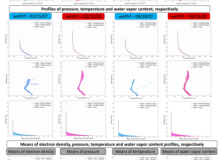Comparison among atmospheric profiles from COSMIC missions
Raphael
Silva Nespolo
São Paulo State University
Poster
The development of GNSS (Global Navigation Satellite Systems) and the launch of missions with LEO (Low Earth Orbit) satellites, enabled the use of radio occultation (RO) technique to terrestrial sounding. One of the benefits offered by this technique is the possibility of retrieving information about inaccessible regions, providing information related to the behavior of the Earth's atmosphere. In 2006, the COSMIC (Constellation Observing System for Meteorology, Ionosphere and Climate) mission was launched, which was highlighted by the large amount of data provided. It was a mission developed to perform observations of the Earth's atmosphere, which brought benefits in several fields, such as meteorology. Although this mission is still in activity, COSMIC-2 was created as a way of continuing the project, which is expected to track more than 4000 profiles per day, providing a large volume of atmospheric data, both for the ionosphere and neutral atmosphere. Among its characteristics, COSMIC-2 has a better coverage on regions of low latitudes, which is especially important considering scenarios such as in the Brazilian region. In this context, the present work aims to present investigations regarding atmospheric profiles, such as pressure profiles, temperature, water vapor pressure and electron density, from COSMIC missions and taking into account the Brazilian territory. This region stands out for a wide variety of climates, for example the Amazon forest presence, contributing to a greater diversification in its atmospheric conditions, mainly regarding the parameters of temperature and pressure of water vapor. In addition, it is located in one of the most challenging regions regarding ionospheric effects, low latitudes. In order to verify the seasonal variations recorded by these missions, the months of June and October were selected for the study on the ionosphere and the periods of February and August for the troposphere. The selection of the years, 2007 for COSMIC and 2020 for COSMIC-2 data, was based on the largest amount of data available from each mission. These periods present distinct characteristics in Brazilian atmosphere, allowing verifying the impact of seasonal effects in the atmospheric profiles.

Poster PDF